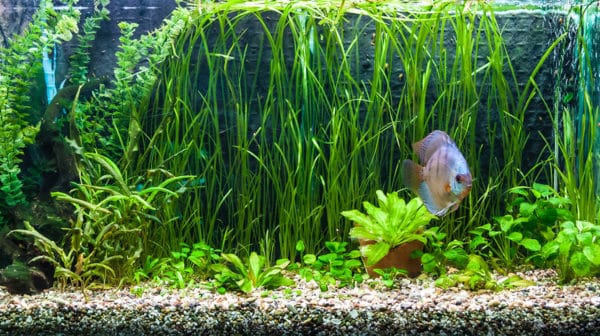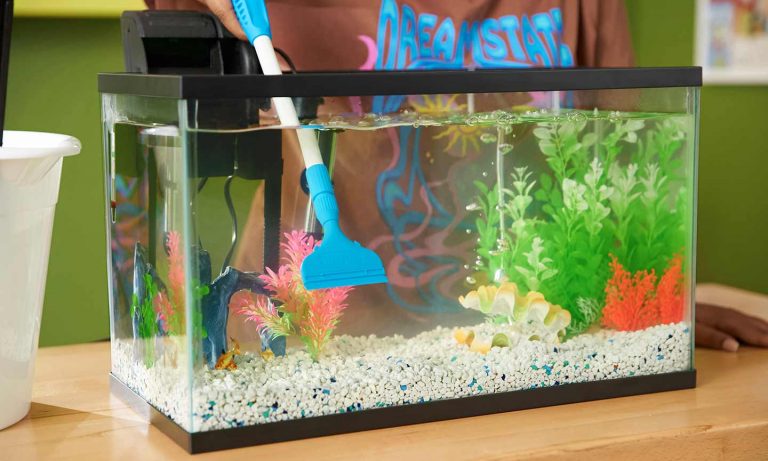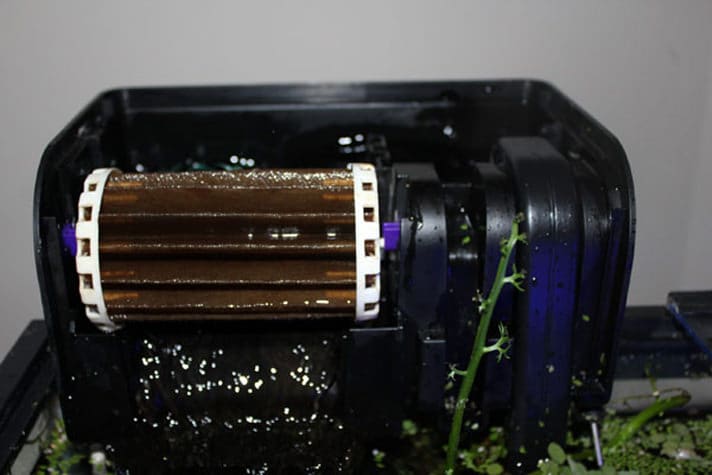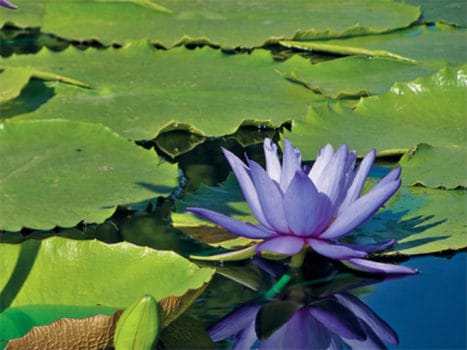Q.
I have recently started purchasing aquatic plants, which last for about three or four months and then just wither away and die. They do not grow, and usually turn pale green. The roots seem to turn brown even though I fertilize and feed.
I have read books and articles in different magazines about aquatic plants and how to keep them. It seems as though this could be a very expensive journey that I’m on.
Here are the conditions and aquarium setup for my 110-gallon aquarium. The aquarium is 60 inches long, and I have three 40-watt tubes in a 48-inch fixture. I have read about halogen lighting and know it is expensive, but is it better?
The aquarium substrate is sand gravel. My reading leads me to believe that a cable heater (expensive) is essential for undergravel aeration. Is this true?
I have two large outside power filters running on the aquarium at the present time. I’m using the regular cartridges along with carbon. I also have a large sponge filter running on a powerhead. I have read that a canister filter is needed for higher levels of carbon dioxide. Is this correct?
I live in a community where agriculture is big. Our tap water is very hard. When I do a water change, the first reading I get from my carbonate hardness test kit is a KH of 9. I then use water softener pillows arranged in a breeding net hung in the water flow. By the time for the next water change, the water is finally down to about 4 KH. Then I have to start all over again.
I purchased a tap water purifier, but only got about 15 gallons of water before it was exhausted. The pH stays at a constant 7.0. The nitrate level in the aquarium is over 25 parts per million, and the phosphate level is above 3 parts per million. Because of the cost of using an ion exchange unit, I have been changing about 10 percent of my water weekly.
I also wanted to know if I have to tear down my aquarium when I finally reach the stage of planting, or is it possible to plant an already established aquarium? Will I have to add substrate fertilizer and so on?
A.
Let me start by saying that you can spend a fortune on gadgets if that aspect of the hobby appeals to you, but there is no reason you can’t have a drop-dead gorgeous planted aquarium without spending a lot of money. In your case, the size of your aquarium dictates that you are going to have to spend more money than a person with a smaller aquarium, but I’m sure you realized that when you bought it.
My rule of thumb for lighting is 2 to 3 watts of full-spectrum fluorescent or metal halide lighting per gallon. This may need to be increased slightly for very large or deep aquariums. For your aquarium this means about 330 watts. It’s not hard to see that with your current 1 watt per gallon, even if everything else in your aquarium were perfect for plant growth, the aquarium would be severely limited for light.
The least expensive fluorescent tubes and fixtures are the 4-foot length. Therefore, the least costly aquariums to light on a per gallon basis are 4 or 8 feet long. For 5- or 6-foot aquariums, you can stagger the 4-foot tubes for coverage, which will give you dimmer areas at the ends of the aquarium, or go to metal halide fixtures. Or you can use smaller (3-foot) tubes end to end, but with this option you will need to run a minimum of six tubes to achieve even a low-moderate light level, and 10 tubes or more if you want to include aquatic plant species that require more light.
You mention halogen lighting, but I suspect you mean metal halide lighting. Metal halides are not “better” for aquatic plants, but they make it possible to fit more light into a smaller space, which is an advantage with a very large or deep aquarium. If you can afford the higher up-front costs, metal halide lighting is actually more cost-efficient than most forms of fluorescent lighting in the long run, both in terms of electricity consumption and re-lamping costs.
The very minimum I would consider over an aquarium of this size would be six 4-foot tubes, either in a custom hood or in three shoplight fixtures staggered over the top of the aquarium. At this light level you will still need to be careful to choose low light-tolerant plants for the aquarium.
Next, let’s look at your substrate. Aquatic plants just don’t grow well in an inert substrate like plain gravel. There are a number of different ways to go on this, but for first-time aquatic gardeners I suggest a good commercially available laterite intended for aquarium use. Laterite is easy to use, will not cause algae problems, and is not a danger to either plants or animals in the system.
Heat cables are a nice addition if you can afford them, but are certainly not a requirement for excellent growth. It is helpful to insulate the bottom of the aquarium to prevent heat loss from the substrate, which can be done inexpensively by seating the aquarium on a sheet of styrofoam.
While canisters are my fish tank filter of choice on larger planted aquariums, your fish tank filters are fine as long as you are replacing carbon dioxide (CO2) lost from the filters with supplemental CO2. There is no real need for the continuous use of carbon in a well-managed planted aquarium.
While your water is certainly on the hard side, it is not any harder than that of many successful aquatic gardeners in Europe. Water softening resins are not particularly useful in a planted aquarium. They just replace the hardness in the water with sodium, which is worse than the original hardness. As you discovered, small deionization (DI) units are quickly exhausted by very hard water.
In your situation, I would first try supplying supplemental CO2 either with a do-it-yourself pressurized CO2 system or, if you want to try it out in a less expensive way first, set up two or three pop bottle yeast reactors. Many aquatic plants are able to do quite well in even harder water as long as they have sufficient light and supplemental CO2. If you are not satisfied with the growth, I would suggest putting the money into a larger DI system. In the long run you will save money. Better still, you will not feel the need to skimp on water changes to conserve your DI filter.
Speaking of water changes, I’m sure your tap water phosphate and nitrate levels are lower than those in your aquarium. You must get those down before you increase the light levels or you will end up with algae problems. I recommend that you keep nitrate below 10 milligrams per liter (mg/L) in a moderately lit aquarium, and phosphate below 1 mg/L. That’s for an aquarium without current algae problems. If you are trying to solve algae problems, I would aim for unmeasurable levels of both. In a brightly lit aquarium (3 watts per gallon or more) the lower readings are necessary to avoid algae problems.
The phosphate and nitrate levels are high enough that I’m quite sure your water changes are not keeping up with the organic input into the aquarium. I would recommend changing 25 to 30 percent twice weekly until the levels are reduced. Then, you can back off to 25 to 30 percent weekly. If the phosphate and nitrate levels remain low, you might be able to slowly reduce water changes, but I would never recommend going below 25 percent every other week.
It is almost always possible to “fix” an established fish aquarium so that you can get at least reasonable growth. However, for a great-looking aquarium, plus taking the high nitrate and phosphate levels into consideration, I would recommend draining the aquarium, reseting the substrate with a good commercial laterite, and refilling with water with lower nutrient levels. If you decide to work with your aquarium as it is now, you can improve the substrate by purchasing laterite in the ball form, These balls can be pushed down into an established substrate in areas where plants will grow. They cause minimal clouding when first pushed into the substrate, and that will settle out in a matter of hours.
Finally, we get to the aquatic plants themselves. I discovered in a conversation with you that most of the aquatic plants you had purchased were non-aquatics. This is the biggest problem of all! It doesn’t matter how well your aquarium is set up if the plants you purchase are not meant for life under water — they will die. Some die slower than others, but in the end, the result is always the same. Buy a book with at least a fair selection of plant identification photos and take it with you whenever you shop for aquatic plants. If you can’t find the aquatic plant in your book, don’t buy it until you are sure it is an aquatic or amphibious plant. If it looks like a house plant, it probably is!
When you plant your aquarium, plan on covering at least 70 percent of the substrate with aquatic plants. At least 60 percent of this plant mass should be fast-growers to handle the macro-nutrients in your tap water and those produced by your fish.
After about the first month, particularly if you are using supplemental CO2 and at least moderate lighting, you will need to start fertilizing. Make sure you choose a complete trace element supplement that contains neither phosphate nor nitrate. These products vary in terms of dosing, but I would suggest starting with half the amount recommended by the manufacturer, and working up slowly based on the response of the plants.
Posted by: Chewy Editorial
Featured Image: Dawn Endico/Flickr
Share:









